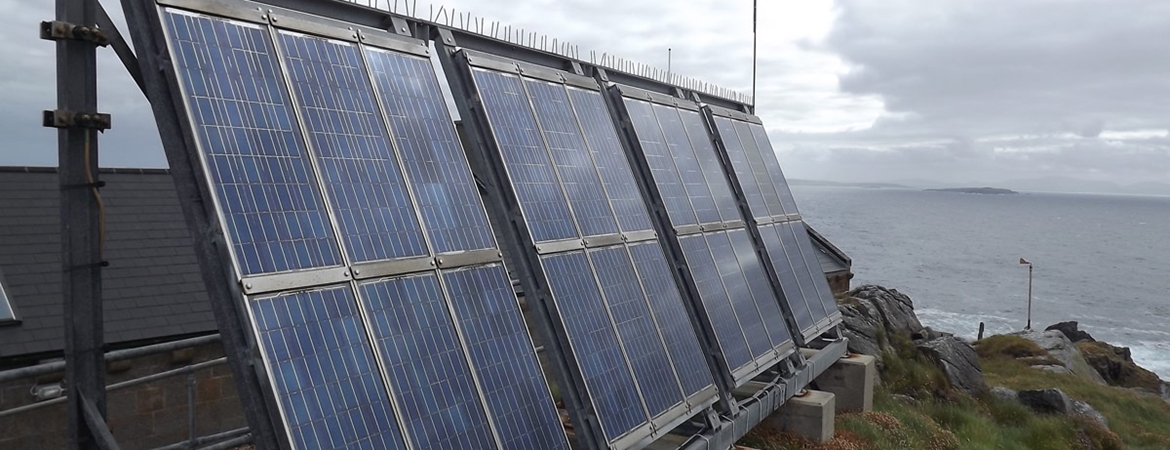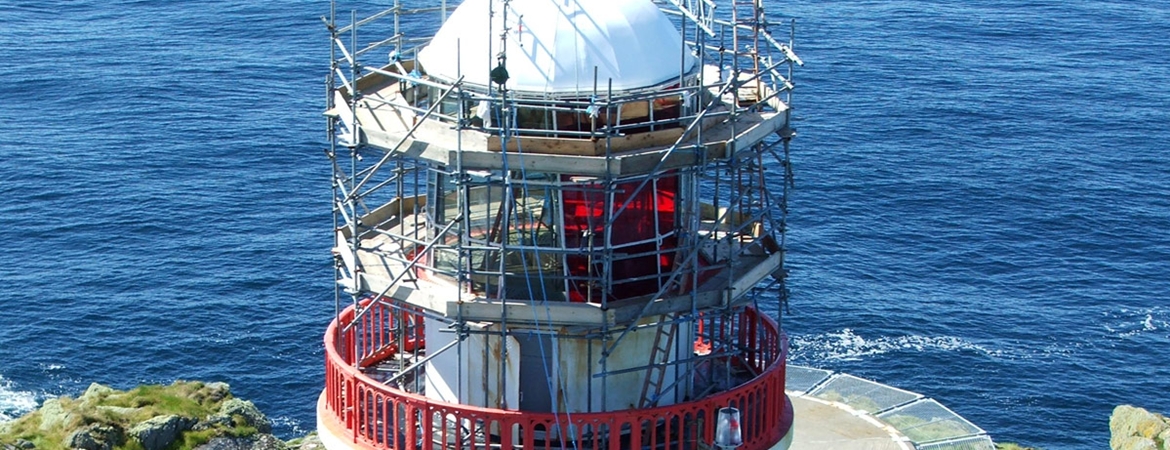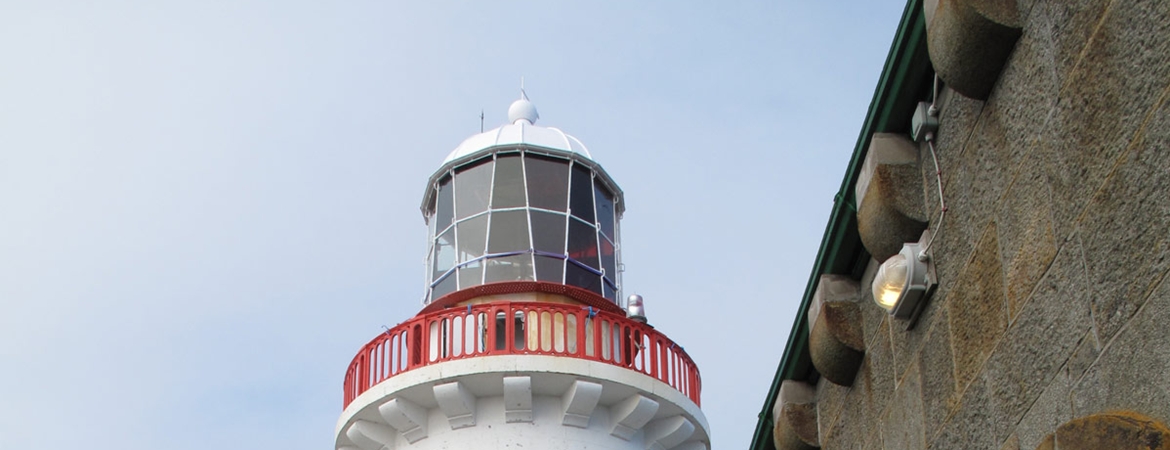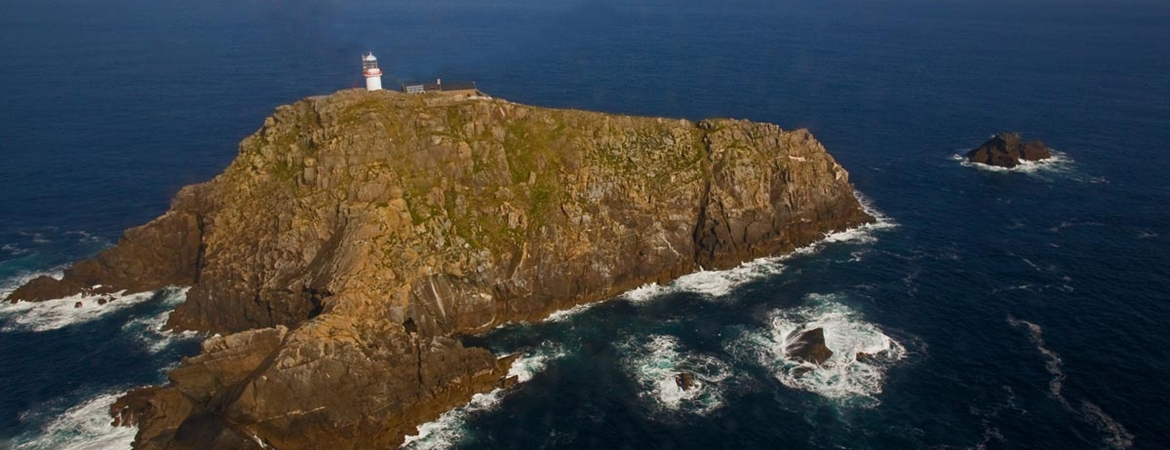In 1830 the Coastguard approached the Corporation for Improving the Port of Dublin for lights to be placed on Slyne Head and Blackrock, north of Achill Island. The subject was referred to Inspector George Halpin who, in his report, agreed that Slyne Head warranted marking but suggested Eagle Island in preference to Blackrock. The Board and Trinity House concurred and stations were established at Eagle Island in 1835, and Slyne Head in 1836, both with twin towers.
The Corporation was again approached by the Coastguard in 1841 and Inspector Halpin still maintained that Eagle Island was better situated as a sea light, but agreed that Blackrock would be a good guide for vessels seeking shelter in Blacksod Bay, in which case it would be necessary to have another light on Blacksod Point. Nothing further was done until early in 1857 when the Board of Trade queried why lights were required at Galley Head, Foze Rocks (Blasket Islands), Bull Rock and Blackrock. The Inspecting Committee made a full report and in their reply the Board of Trade regarded Blackrock as the more important of the four stations. Trinity House, who were also involved, sent a committee of Elder Brethren over to inspect the three proposed west coast rocks for lighthouses and on their return gave Statutory Sanction for Blackrock.
The first order dioptric revolving apparatus was ordered in December 1861 from Chance Brothers and the lantern from Neilkins. Unfortunately, due to weather conditions, neither the lantern or the apparatus could be landed on the rock in November 1862, so they were stored in Belmullet until the following summer when they were safely landed.
The circular tower, 50 feet high, is positioned on the western extremity of Blackrock and built of stone of the rock. The light, flashing white to sea and red to land once every 30 seconds was first exhibited on 1st June 1864. It was 282 feet above high water and visible for 22 miles. The tower lantern and dome was, and still is, painted white.
Dwellings for keepers were built at Blacksod and the rock became relieving early in 1863. On two occasions, the first before the dwellings were built and the second for ten years after the turn of the century, a tramway owned by the Blacksod Granite Company passed through the land on which the dwellings were built, from the quarry to the pier. Part of the track bed can still be seen. In 1956 the Eagle Island dwellings at Corclough, towards the northern end of The Mullet were sold and in 1957 the Blackrock Mayo dwellings were also sold.
In 1908 the candlepower of the light was increased by replacing the wide burner with an incandescent paraffin vapour burner and associated gear.
On the 20th August 1940 lantern panes and the roofs were damaged by gunfire from a German bomber attacking the SS Macville which was close to the rock, fortunately no keepers were hurt.
1969 was a significant year for twelve west coast rock stations from Fastnet to Inishtrahull including Blackrock Mayo. Boat reliefs were changed to helicopter reliefs. This was on a trial basis at first but became a permanent feature.
The conversion of the light to unwatched went ahead and on 12th July 1974 a temporary light with a single flash every 12 seconds was exhibited from the balcony. This was to allow the old lens and paraffin incandescent gear to be replaced by an AGA acetylene gas operated revolving optic giving a single flash every 12 seconds. The new light was put into operation on Thursday 5th September 1974 with a nominal range of 22 miles (white) and 16 miles (red). The light source was an incandescent mantle illuminated by a mixture of acetylene gas and air. Should the mantle break, one of three standby mantles was brought automatically into position. The pressure energy of the gas is sufficient to rotate the lens. A sunvalve positioned outside the lantern opened the gas valve at dusk and closed it at dawn and a pilot light ignited the main burner. To prevent the sun burning through the lens during day time the optic was kept rotating at a slow speed.
In mid November 1974 the conversion to automatic operation was completed and the Keepers were withdrawn from the station.
A 12 kW generating set supplies power for cooking, and for lighting and heating the 'Portacabin' accommodation which replaced the damp 1864 dwellings.
The Corporation was again approached by the Coastguard in 1841 and Inspector Halpin still maintained that Eagle Island was better situated as a sea light, but agreed that Blackrock would be a good guide for vessels seeking shelter in Blacksod Bay, in which case it would be necessary to have another light on Blacksod Point. Nothing further was done until early in 1857 when the Board of Trade queried why lights were required at Galley Head, Foze Rocks (Blasket Islands), Bull Rock and Blackrock. The Inspecting Committee made a full report and in their reply the Board of Trade regarded Blackrock as the more important of the four stations. Trinity House, who were also involved, sent a committee of Elder Brethren over to inspect the three proposed west coast rocks for lighthouses and on their return gave Statutory Sanction for Blackrock.
The first order dioptric revolving apparatus was ordered in December 1861 from Chance Brothers and the lantern from Neilkins. Unfortunately, due to weather conditions, neither the lantern or the apparatus could be landed on the rock in November 1862, so they were stored in Belmullet until the following summer when they were safely landed.
The circular tower, 50 feet high, is positioned on the western extremity of Blackrock and built of stone of the rock. The light, flashing white to sea and red to land once every 30 seconds was first exhibited on 1st June 1864. It was 282 feet above high water and visible for 22 miles. The tower lantern and dome was, and still is, painted white.
Dwellings for keepers were built at Blacksod and the rock became relieving early in 1863. On two occasions, the first before the dwellings were built and the second for ten years after the turn of the century, a tramway owned by the Blacksod Granite Company passed through the land on which the dwellings were built, from the quarry to the pier. Part of the track bed can still be seen. In 1956 the Eagle Island dwellings at Corclough, towards the northern end of The Mullet were sold and in 1957 the Blackrock Mayo dwellings were also sold.
In 1908 the candlepower of the light was increased by replacing the wide burner with an incandescent paraffin vapour burner and associated gear.
On the 20th August 1940 lantern panes and the roofs were damaged by gunfire from a German bomber attacking the SS Macville which was close to the rock, fortunately no keepers were hurt.
1969 was a significant year for twelve west coast rock stations from Fastnet to Inishtrahull including Blackrock Mayo. Boat reliefs were changed to helicopter reliefs. This was on a trial basis at first but became a permanent feature.
The conversion of the light to unwatched went ahead and on 12th July 1974 a temporary light with a single flash every 12 seconds was exhibited from the balcony. This was to allow the old lens and paraffin incandescent gear to be replaced by an AGA acetylene gas operated revolving optic giving a single flash every 12 seconds. The new light was put into operation on Thursday 5th September 1974 with a nominal range of 22 miles (white) and 16 miles (red). The light source was an incandescent mantle illuminated by a mixture of acetylene gas and air. Should the mantle break, one of three standby mantles was brought automatically into position. The pressure energy of the gas is sufficient to rotate the lens. A sunvalve positioned outside the lantern opened the gas valve at dusk and closed it at dawn and a pilot light ignited the main burner. To prevent the sun burning through the lens during day time the optic was kept rotating at a slow speed.
In mid November 1974 the conversion to automatic operation was completed and the Keepers were withdrawn from the station.
A 12 kW generating set supplies power for cooking, and for lighting and heating the 'Portacabin' accommodation which replaced the damp 1864 dwellings.
On the 3rd August 1999 the light source at Blackrock Mayo was converted to solar power using a PRL400 electric lantern and 35W discharge lamp powered by 24 50W solar panels and a 24V 6,600 Ah battery giving a range of 20 nautical miles (white) and 16 nautical miles (red).
The station is now in the care of an Attendant who visits the station with his Assistant periodically to carry out routine maintenance and housekeeping, and the aids to navigation are also monitored via a telemetry link from Irish Lights in Dun Laoghaire.











